West African cuisine has a rich history and a diverse range of ingredients that have shaped the past and present diets of the region. The traditional African diet consists of a main meal at lunchtime, which often includes a mixture of vegetables, legumes, and sometimes meat. Staples in the West African diet include rice, yam, cassava, millet, and maize. The cuisine is known for its use of spices and flavourings, often influenced by trade and cultural exchanges. Traditional cooking methods include boiling, frying, grilling, roasting, and baking. In recent years, there has been a growing interest in adapting West African dishes to vegan and vegetarian diets, using plant-based ingredients to create flavorful and nutritious meals. Plant foods such as mushrooms, lemongrass, coconut, and seasonal fruits play key roles in these adaptations. While the term “vegan” may not easily apply to West African food, the concept of “plant-based” or “vegetarian” is commonly used. Overall, exploring the past and present diets of West Africa reveals a diverse culinary heritage that continues to evolve and adapt.
Key Takeaways:
- West African cuisine has a rich history and a diverse range of ingredients.
- Staples in the West African diet include rice, yam, cassava, millet, and maize.
- Traditional cooking methods in West Africa include boiling, frying, grilling, roasting, and baking.
- There is a growing interest in adapting West African dishes to vegan and vegetarian diets.
- Plant-based ingredients such as mushrooms, lemongrass, coconut, and seasonal fruits are key to these adaptations.
The traditional West African diet consists of a main meal at lunchtime, featuring a mix of vegetables, legumes, and occasionally meat, with staples such as rice, yam, cassava, millet, and maize. These ingredients form the foundation of West African cuisine, which is known for its rich flavours and vibrant colours.
The culinary traditions of West Africa have been shaped by centuries of trade and cultural exchanges, resulting in a diverse range of dishes and flavours. Spices and flavourings like ginger, garlic, cloves, and chilli peppers are commonly used to add depth and complexity to the food.
Traditional cooking methods, such as boiling, frying, grilling, roasting, and baking, are employed to enhance the natural flavours and textures of the ingredients. The meticulous preparation and cooking techniques are an integral part of West African cooking, ensuring that each dish is a culinary masterpiece.
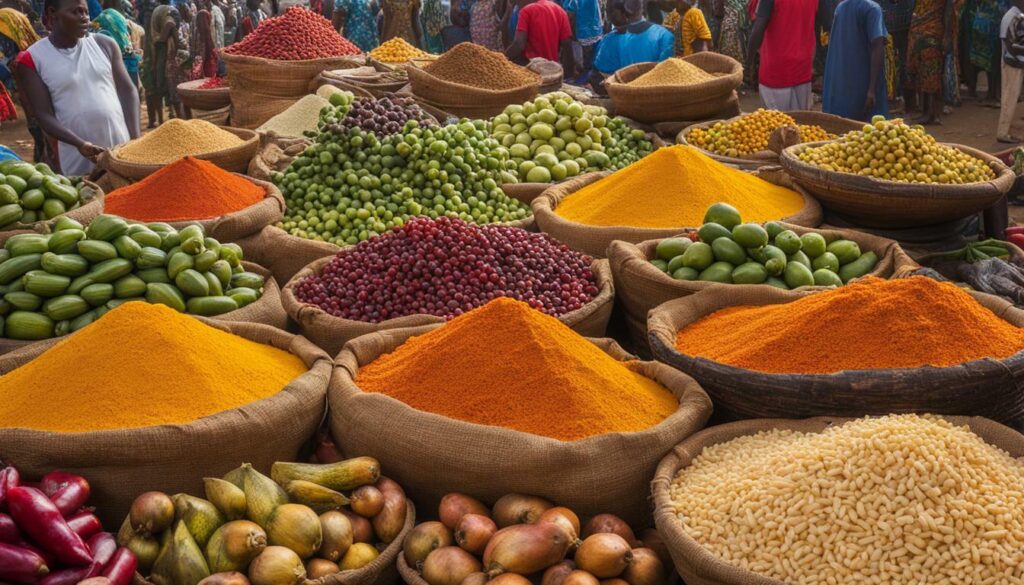
The traditional West African diet is not only delicious but also nutritious. It is rich in fibre, vitamins, and minerals, thanks to the abundant use of fresh vegetables and legumes. The inclusion of meat, such as chicken, beef, and fish, provides a good source of protein. Traditional West African recipes often emphasize the balance of flavours and textures, creating a well-rounded and satisfying meal.
| Staple Foods | Common Ingredients |
|---|---|
| Rice | Tomatoes, onions, peppers |
| Yam | Okra, garden eggs, palm oil |
| Cassava | Egusi, spinach, smoked fish |
| Millet | Groundnut, baobab leaves |
| Maize | Peanut, plantain, ginger |
These staple foods and common ingredients are used in a variety of traditional West African recipes, creating a culinary experience that reflects the diversity of the region. From hearty stews like jollof rice and egusi soup to flavorful snacks like akara and puff puff, West African cuisine has something to offer for every palate.
Evolution of West African Diets
The diets of West Africa have evolved, influenced by various cultural interactions and historical events that have left a lasting impact on the region’s culinary traditions. Trade routes played a significant role in introducing new ingredients and flavours to West African cuisines. The arrival of Arab traders brought spices such as cinnamon, cloves, and ginger, which added depth and complexity to dishes. Likewise, the Portuguese traders introduced chilli peppers, tomatoes, and peanuts, which have become integral ingredients in many West African recipes.
The colonial era also had a profound impact on West African diets. European colonization brought with it new crops and culinary practices. The introduction of maize, potatoes, and beans expanded the range of ingredients available, influencing the diversity of dishes. Furthermore, the forced migration of enslaved Africans to the Americas resulted in the exchange of culinary traditions between West Africa and the New World. This “Columbian Exchange” introduced ingredients like okra, black-eyed peas, and sweet potatoes to West African cooking.
The blending of cultures through trade and colonization also led to the development of fusion cuisines in West Africa. The fusion of West African, Portuguese, and Brazilian cooking techniques resulted in the creation of dishes like “Moqueca” and “Caldo de Mancarra” that showcase the unique blend of flavours and ingredients from multiple culinary traditions. These dishes stand as a testament to the enduring cultural influences on West African diets.

In summary, the evolution of West African diets reflects a rich history of cultural exchanges and historical events. From ancient trade routes to colonial influences, the region’s culinary traditions have been shaped by a diverse range of ingredients and cooking techniques. Today, West African cuisine continues to adapt and innovate, incorporating elements from both its past and present to create a vibrant and flavorful culinary experience.
West African Cuisine Today
West African cuisine today encompasses a wide range of dishes that reflect the region’s cultural diversity and nutritional needs. With a rich culinary heritage, West Africa offers a tantalizing array of flavours and ingredients that have captivated the taste buds of both locals and international food enthusiasts.
Popular West African dishes include jollof rice, a flavorful one-pot rice dish cooked with tomatoes, onions, and various spices. Another beloved dish is egusi soup, made with ground melon seeds, vegetables, and traditional spices. These dishes, along with many others, showcase the vibrant and diverse food culture of West Africa.
In addition to its delicious flavours, West African cuisine is also known for its nutritional value. The traditional diet emphasizes a balanced intake of protein, carbohydrates, and vitamins. Staples like yam, cassava, and maize provide a good source of energy, while vegetables and legumes contribute essential nutrients. This emphasis on wholesome ingredients showcases the region’s commitment to maintaining a healthy lifestyle through food.
| Dish | Description |
|---|---|
| Jollof Rice | A flavorful rice dish cooked with tomatoes, onions, and spices. |
| Egusi Soup | A soup made with ground melon seeds, vegetables, and traditional spices. |
| Fried Plantains | Sliced plantains fried until golden brown, often served as a side dish or snack. |
“West African cuisine is a beautiful blend of flavors, colors, and textures. It is a true reflection of the region’s vibrant food culture and rich history.”
West African cuisine continues to evolve and adapt to modern tastes and dietary practices. Today, there is a growing interest in vegan and vegetarian adaptations of traditional West African dishes. By using plant-based ingredients such as mushrooms, lemongrass, coconut, and seasonal fruits, chefs and home cooks alike can create mouthwatering plant-based meals that pay homage to the region’s culinary traditions.
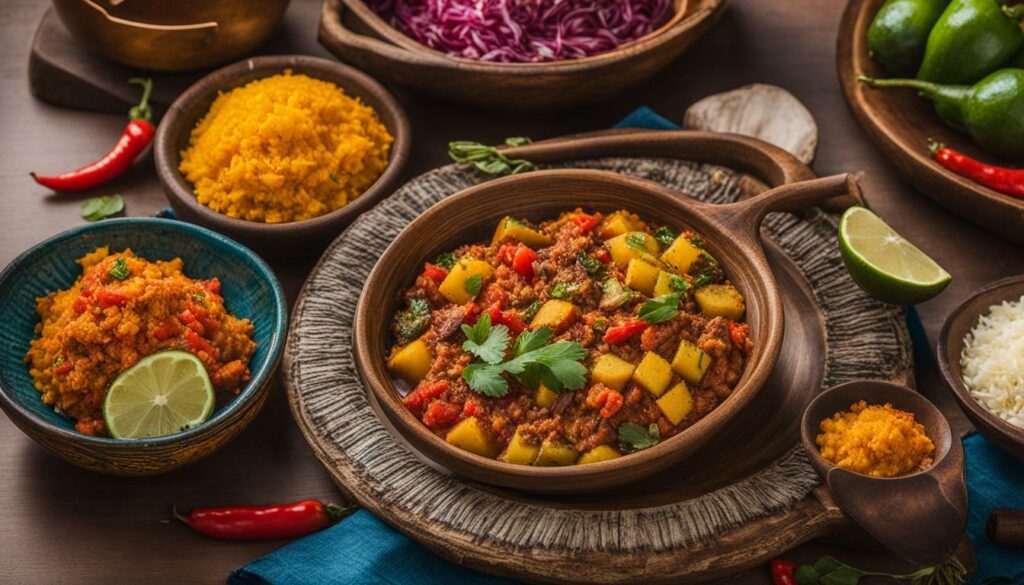
Traditional West African Cooking Methods
Traditional West African cooking methods play a crucial role in bringing out the unique flavours and textures of the region’s dishes. Boiling, frying, grilling, roasting, and baking are commonly used techniques that have been passed down through generations. These methods not only enhance the taste of the ingredients but also preserve their nutritional value.
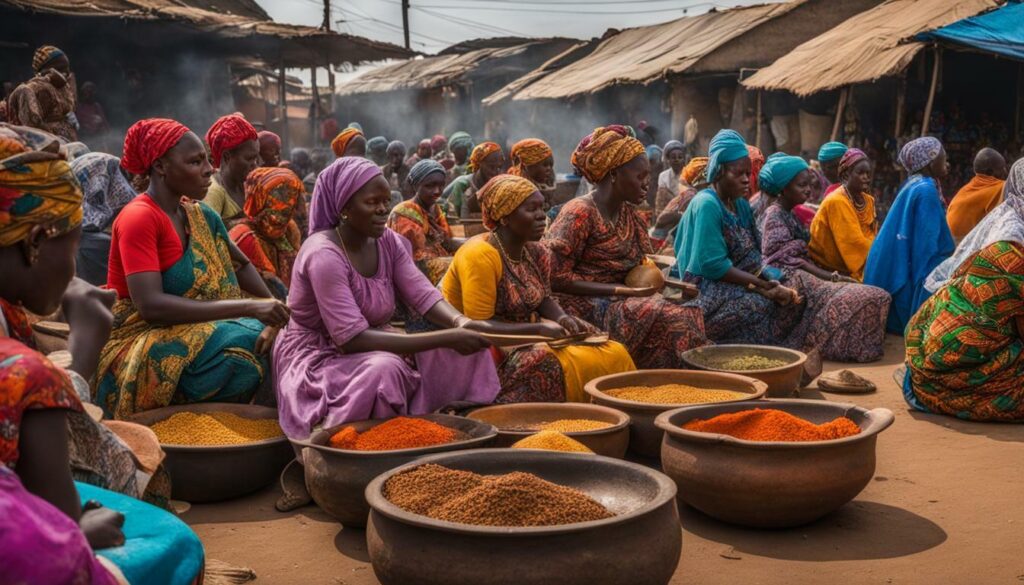
West African cuisine is known for its bold and vibrant flavors, achieved through the skillful use of spices and flavorings. Whether it’s slow-cooking a stew on an open fire or grilling meat over hot coals, these traditional cooking methods infuse the dishes with a smoky and aromatic essence.
In West African cuisine, boiling is commonly used to prepare soups and stews. A variety of ingredients, such as vegetables, meat, and fish, are simmered together in a flavorful broth, allowing the flavours to meld and intensify. Frying, on the other hand, adds a crispy texture to ingredients like plantains or yams. The use of palm oil in frying also adds a distinct flavour to the dishes.
Grilling and roasting are popular methods for cooking meat, fish, and poultry in West Africa. These techniques create a smoky flavour and a slightly charred exterior, giving the dishes a deliciously caramelized taste. Baking is often used for bread and pastries, with millet and maize being staple ingredients in West African baking.
| Traditional Cooking Methods in West Africa | Description |
|---|---|
| Boiling | Simmering ingredients in a flavorful broth to create soups and stews. |
| Frying | Adding a crispy texture to ingredients like plantains and yams with the use of palm oil. |
| Grilling | Cooking meat, fish, and poultry over hot coals to achieve a smoky flavor. |
| Roasting | Preparing ingredients with a slightly charred and caramelized exterior. |
| Baking | Using traditional ingredients like millet and maize for bread and pastries. |
The art of traditional West African cooking methods is deeply rooted in the region’s culture and history. These techniques not only create delicious meals but also connect communities through shared culinary traditions. By preserving and embracing these methods, West African cuisine continues to thrive and captivate taste buds around the world.
Traditional West African Recipes
Traditional West African recipes are an essential part of the region’s culinary tradition, showcasing the unique flavours and cooking techniques that have been preserved over time. These recipes often feature a variety of locally sourced ingredients, including indigenous fruits, vegetables, and protein sources.
One popular traditional dish in West Africa is Jollof rice, a flavorful one-pot meal made with rice, tomatoes, onions, and a blend of spices. This dish is known for its vibrant red colour and is often served with grilled or fried meat, fish, or chicken. Another classic West African recipe is Egusi soup, made with ground melon seeds, vegetables, and meat or fish. Egusi soup is rich and hearty, often enjoyed with fufu, a dough-like staple made from cassava, plantain, or yam.
In addition to these well-known dishes, West African cuisine offers a wide range of unique delicacies. For example, Suya is a popular street food consisting of skewered meat, typically beef or chicken, coated in a spicy peanut sauce and then grilled over an open flame. Akara, a savoury fried bean cake, is often enjoyed as a breakfast or snack food. It is made by blending black-eyed peas with spices, onions, and peppers, then deep-frying the mixture until golden brown.
West African recipes are not just about the flavours; they also reflect the region’s cultural traditions and social gatherings. Food plays a central role in West African communities, bringing people together to celebrate, share stories, and preserve their heritage. This culinary tradition is a testament to the richness and diversity of West African culture.

| Recipe | Ingredients | Method |
|---|---|---|
| Jollof Rice | Rice, tomatoes, onions, spices, meat or fish | 1. Blend melon seeds with water to form a paste. 2. Sauté onions and vegetables in palm oil. 3. Add the melon seed paste and meat or fish. 4. Simmer until the flavours are fully developed. |
| Egusi Soup | Ground melon seeds, vegetables, meat or fish | 1. Blend melon seeds with water to form a paste. 2. Sauté onions and vegetables in palm oil. 3. Add the melon seed paste and meat or fish. 4. Simmer until the flavors are fully developed. |
| Suya | Beef or chicken, peanut sauce, spices | 1. Marinate the meat in peanut sauce and spices for a few hours. 2. Skewer the meat and grill it over an open flame. 3. Baste with more peanut sauce while grilling. 4. Serve hot with sliced onions and tomatoes. |
| Akara | Black-eyed peas, onions, peppers, spices | 1. Soak |
These traditional West African recipes provide a taste of the region’s culinary heritage, offering a flavorful journey through the diverse flavours and cooking techniques that have been passed down through generations. Whether enjoyed at home or in West African restaurants around the world, these recipes allow individuals to experience the rich cultural tapestry that makes West African cuisine so unique.
Adaptations to Vegan and Vegetarian Diets
In recent years, there has been a growing interest in adapting West African dishes to vegan and vegetarian diets, resulting in the incorporation of plant-based ingredients to create delicious and nutritious meals. While the term “vegan” may not easily apply to West African food, the concept of “plant-based” or “vegetarian” is commonly used to describe these adaptations. By using a variety of plant foods, West African cuisine can easily be adapted to suit different dietary preferences without compromising on flavour or cultural authenticity.
One of the key ingredients in plant-based West African dishes is mushrooms. With their meaty texture and umami flavour, mushrooms are often used as a substitute for meat in classic West African recipes. They can be sautéed, grilled, or stewed to add depth and richness to dishes like jollof rice or groundnut stew.
Lemongrass is another plant-based ingredient that adds a vibrant and citrusy flavour to West African dishes. It is often used to infuse soups, stews, and marinades with its refreshing aroma. Coconut, with its creamy texture and tropical taste, is also a popular addition to plant-based West African recipes. It can be used in both sweet and savoury dishes, from coconut rice to coconut curry.
Seasonal fruits play an important role in plant-based West African cuisine as well. Fruits like mangoes, papayas, and pineapples are often used to add a touch of sweetness and freshness to salads, salsas, and desserts. By incorporating these fruits into traditional recipes, vegan and vegetarian adaptations can capture the vibrant flavours of West Africa’s culinary traditions.
| Key Ingredients in Plant-Based West African Dishes |
|---|
| Mushrooms |
| Lemongrass |
| Coconut |
| Seasonal fruits |

Overall, the adaptations to vegan and vegetarian diets in West African cuisine showcase the creativity and versatility of this culinary tradition. By embracing plant-based ingredients, West African dishes can cater to a wider range of dietary preferences while honouring the rich flavours and cultural heritage of the region.
Key Ingredients in Plant-Based West African Dishes
Plant foods such as mushrooms, lemongrass, coconut, and seasonal fruits play a crucial role in creating flavorful and nutritious vegan and vegetarian adaptations of West African dishes. These ingredients add depth and complexity to the traditional flavours of West African cuisine, while also providing a range of health benefits.
Mushrooms are widely used in West African cooking, offering a meaty texture and earthy taste to plant-based dishes. Varieties such as oyster, shiitake, and portobello are commonly used in stews and soups, infusing them with a rich umami flavour. Lemongrass, with its citrusy and herbal notes, is another staple ingredient that brings a refreshing twist to West African recipes. It is often used in marinades, sauces, and grilled dishes.
Coconut, a versatile ingredient, is an essential component of West African plant-based cooking. Coconut milk and cream are used to create creamy sauces and curries, while grated coconut adds a tropical touch to desserts and snacks. Additionally, seasonal fruits like mangoes, pineapples, and bananas are enjoyed as snacks or incorporated into dishes, providing natural sweetness and vibrant flavours.
| Ingredient | Role in West African Cuisine |
|---|---|
| Mushrooms | Add natural sweetness and vibrant flavours |
| Lemongrass | Infuse dishes with citrusy and herbal notes |
| Coconut | Provide creamy texture and tropical taste |
| Seasonal fruits | Add natural sweetness and vibrant flavors |
As more individuals embrace plant-based diets, West African cuisine has adapted to accommodate these dietary preferences. By incorporating these key plant-based ingredients, West African dishes not only cater to vegans and vegetarians but also offer a unique and enticing dining experience for all. The flavorful combinations and diverse range of ingredients continue to showcase the rich culinary heritage and evolving food culture of West Africa.
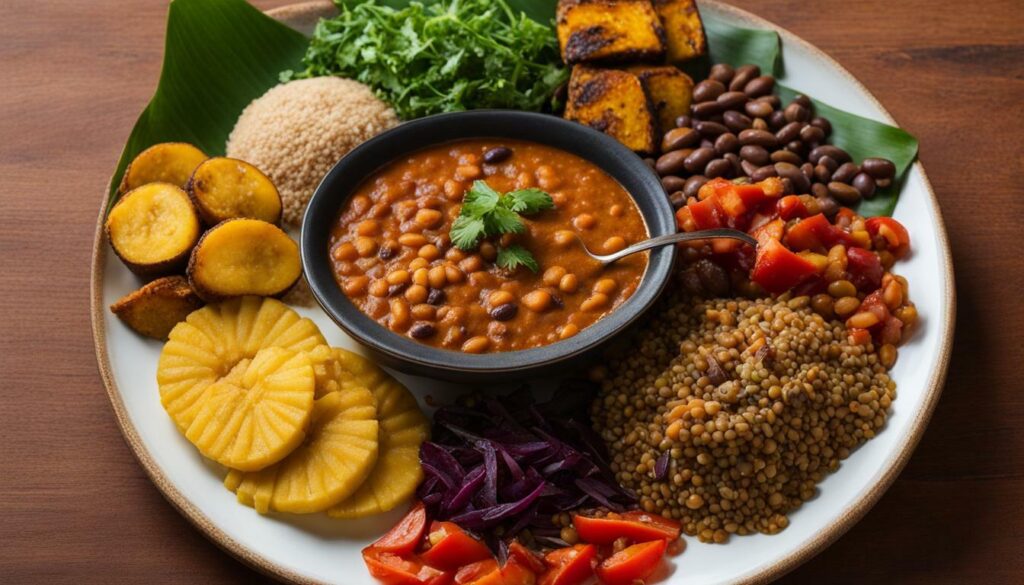
Staples like rice, yam, cassava, millet, and maize form the foundation of West African cuisine, with variations based on seasons and regional preferences. These staple foods are not only essential sources of carbohydrates but also provide vital nutrients. In the coastal regions, rice is a popular choice, while yam is favoured in the savannah areas. Cassava, a versatile root vegetable, is widely consumed throughout West Africa, often used to make fufu, a starchy accompaniment to many dishes. Millet and maize are commonly found in the diets of West Africans, especially in the Sahel and Guinea regions.
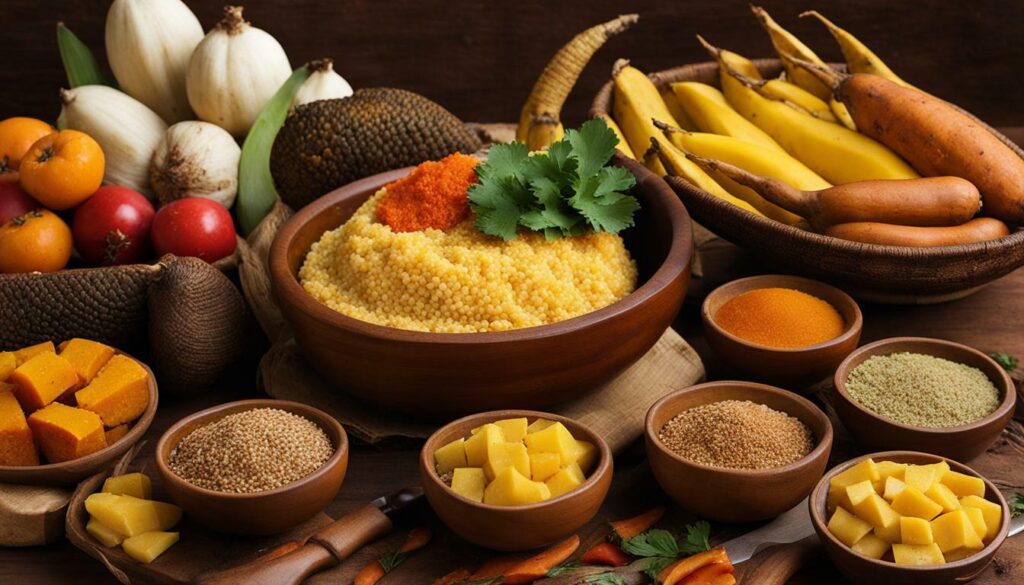
Seasonality plays a significant role in shaping the culinary traditions of West Africa. The availability of fresh produce and agricultural cycles influence the composition of meals. For instance, during the rainy season, leafy greens such as spinach and kale are abundant, while the dry season brings about an abundance of root vegetables like yam and sweet potato. This seasonal variation not only adds diversity to the cuisine but also ensures that people are consuming a range of nutrients throughout the year.
Seasonality plays a significant role in shaping the culinary traditions of West Africa.
Regional Differences
West Africa is a vast region with diverse cultural and geographical landscapes. As a result, there are variations in staple foods and culinary traditions across different sub-regions. For example, in Nigeria, a popular dish called jollof rice is common, while in Senegal, thieboudienne, a flavorful rice and fish dish, takes centre stage. Regional preferences also influence the choice of spices and flavourings used in dishes, creating unique flavour profiles that reflect the local culture and history.
| Country | Staple Food | Popular Dish |
|---|---|---|
| Nigeria | Rice | Jollof Rice |
| Ghana | Corn | Banku |
| Senegal | Rice | Thieboudienne |
Exploring the staple foods and seasonal variations in West African cuisine provides a glimpse into the diverse culinary heritage of the region. From the use of rice, yam, cassava, millet, and maize as foundational ingredients to the regional variations and seasonal influences, West African dishes are a celebration of culture and flavours. With each mouthful, one can taste the rich history and traditions that have shaped the cuisine for centuries.
Conclusion
Exploring the past and present diets of West Africa reveals a diverse culinary heritage that continues to evolve and adapt, reflecting the cultural significance of food and the dietary habits in the region.
The traditional African diet consists of a main meal at lunchtime, which often includes a mixture of vegetables, legumes, and sometimes meat. Staples in the West African diet include rice, yam, cassava, millet, and maize. The cuisine is known for its use of spices and flavourings, often influenced by trade and cultural exchanges.
Traditional cooking methods in West Africa include boiling, frying, grilling, roasting, and baking. These methods are key in preserving the flavours and textures of West African dishes.
In recent years, there has been a growing interest in adapting West African dishes to vegan and vegetarian diets. While the term “vegan” may not easily apply to West African food, the concept of “plant-based” or “vegetarian” is commonly used. Plant foods such as mushrooms, lemongrass, coconut, and seasonal fruits play key roles in these adaptations, adding depth and flavour to the dishes.
The rich history and diverse range of ingredients in West African cuisine provide a unique insight into the culinary heritage of the region. With its ongoing evolution and adaptation, West African cuisine continues to captivate taste buds and showcase the cultural significance of food and the dietary habits of the people.
FAQ
What does the traditional West African diet consist of?
The traditional West African diet consists of a main meal at lunchtime, which often includes a mixture of vegetables, legumes, and sometimes meat. Staples in the diet include rice, yam, cassava, millet, and maize.
What are the traditional cooking methods used in West Africa?
Traditional West African cooking methods include boiling, frying, grilling, roasting, and baking. These methods are used to preserve the flavours and textures of West African dishes.
How has West African cuisine adapted to vegan and vegetarian diets?
In recent years, there has been a growing interest in adapting West African dishes to vegan and vegetarian diets. Plant-based ingredients are used to create flavorful and nutritious meals while staying true to the traditional culinary traditions of West Africa.
What are some key ingredients in plant-based West African dishes?
Key ingredients in plant-based West African dishes include mushrooms, lemongrass, coconut, and seasonal fruits. These ingredients add depth and flavour to the dishes.
What are the staple foods in West Africa?
The staple foods in West Africa include rice, yam, cassava, millet, and maize. These foods vary based on seasons and regions and are significant in popular West African dishes.
Source Links
- https://www.encyclopedia.com/food/news-wires-white-papers-and-books/africans-diets
- https://phys.org/news/2022-01-west-african-cuisine.html
- https://www.nytimes.com/2021/12/14/dining/plant-based-west-african-cuisine.html
Read Our Articles On The Other Regions of Africa Here:
| Past and Present Diets of North Africa |
| Past and Present Diets of East Africa |
| Past and Present Diets of Central Africa |
| Past and Present Diets of Southern Africa |
| Past and Present Diets Sub-Saharan Africa |



